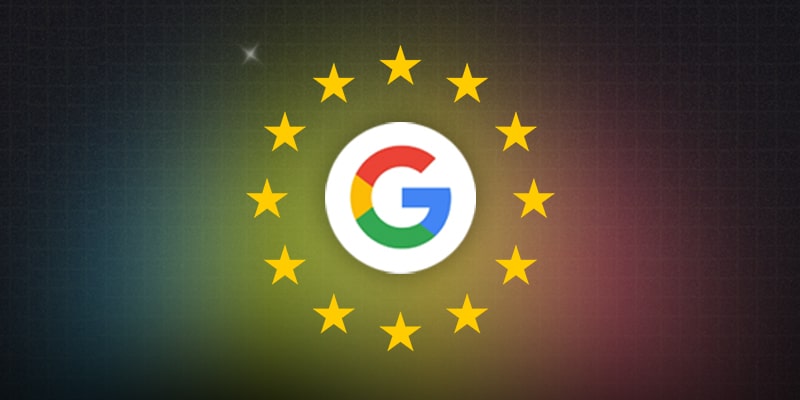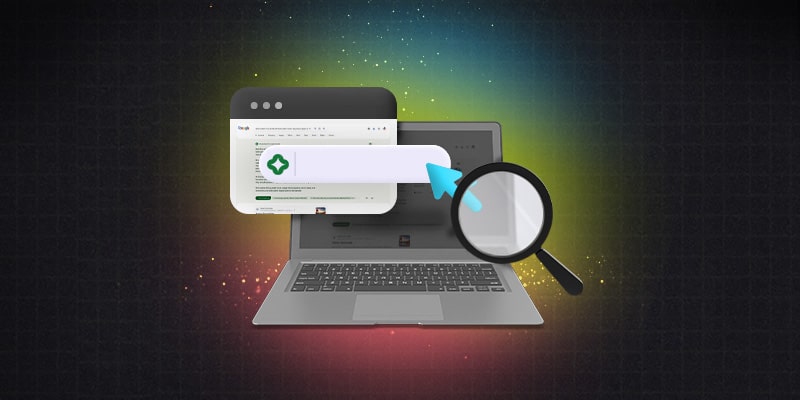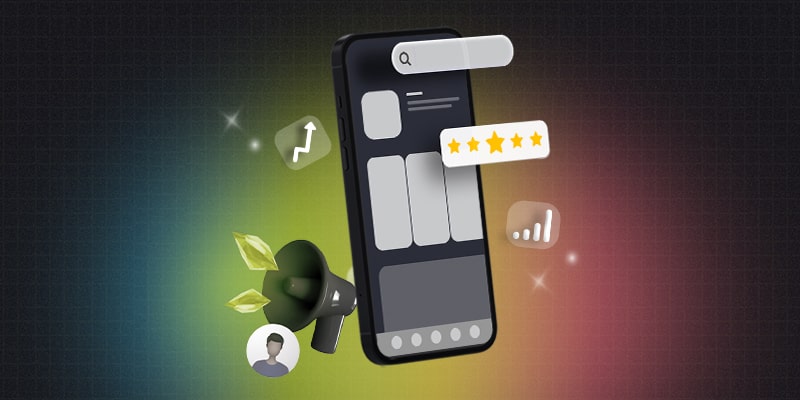How to Get the Most Out of Twitter Ads

They may not be as talked about as Facebook or Google, but if you’re a marketer running mobile app install campaigns, you may want to give Twitter Ads a second look. When used correctly they can generate quick wins that many marketers are missing out on, in addition to boasting some compelling advantages to the alternatives, such as other major ad networks.
Before we get started though, it’s important to note that Twitter Ads are not necessarily “vertical agnostic” when it comes to their efficacy, and not every industry is the right fit. Although, for apps in the shopping, finance, and news spaces (not to mention politics) they are seemingly almost tailor-made.
Campaign Strategy & Optimization
Name Your Price Per Install
One interesting feature that Twitter Ads offers is the ability to learn about your audience at no cost to you when using a CPI model. This is because unlike some of the other social platforms you can choose to be charged exclusively for app installs generated by your campaign right out of the gate. This differs from other platforms that make you pay for impressions or clicks while its algorithm runs its “learning phase.” In fact, Facebook doesn’t even offer installs as an option to be charged by in the beginning and won’t (for lack of a better word) unlock it until you’ve reached its algorithm’s threshold of data needed to determine who are the best people to show your ad. Furthermore, platforms such as Google (UAC campaigns) even suggest locking yourself in for a period of 7 to 10 days and hold off from doing any optimization when it comes to your budget while it conducts its learning phase.
This contrasts with Twitter which allows you to test out their system for free. Well, not exactly for free, but allow us to explain. Rather than pay for the actions you aren’t interested in and will eat through your budgets, such as impressions and clicks, Twitter lets you save your money by only paying for those you do, in other words, app installs. From our experience, it is the exception to all the other major social platforms in providing this option immediately from your campaign’s launch. This includes Apple Search Ads as well, where no matter how much time and money you invest you’ll never be able to achieve this payment method, and will always be paying for taps.
Something to Consider: For startups, the defacto “free trial” Twitter Ads offers could be a helpful resource both when it comes to budgeting for user acquisition, as well as for calculating customer LTV.
An App Install Campaign Cure-All? Well, Not So Fast
Now, to be clear, we are not suggesting that the learning phase isn’t an essential element of your campaign. In reality, it’s a near impossibility to achieve any success with it at scale without allowing a platform’s algorithm to do its thing. Additionally, if you don’t find your app install “sweet spot” when it comes to the bid, you can conceivably be running a campaign indefinitely that generates nothing. While it’s true that you won’t incur any financial expense in doing so, the amount you’ll be spending on your time, an ever depreciating asset, is certainly an expense worth considering.
Worst Case Scenario, Go Back to School
As mentioned earlier, if you have a lesser known brand or perhaps one that is not necessarily in one of the more popular verticals that appeal to Twitter, this “fire away in the dark hoping to hit something” approach may result in you spinning your wheels and wasting time. If that’s the case and you find yourself literally going nowhere, simply switch over to a different model, such optimized action bidding (OAB), where you pay for clicks but bid for installs. That way you’ll gain more reach and exposure, while still maintaining a lower amount you’ll pay on a cost per install. In short, you’re back to paying for the algorithm’s learning phase, much like you would be doing on any other platform. However, once you feel confident that you’ve found the right CPI benchmark, now you can revert to the charging/payment model again, and resume paying only for what you want.
More Targeting Flexibility
Every social platform offers a certain set of capabilities when it comes to reaching your intended audience including via interest, or lookalike audience. While Twitter has these as options too, it also offers unique ways to reach the right people not exactly available on other networks. Some of these unique targeting capabilities include by keyword targeting, by interest targeting, by handles, and even by current events. In short, when it comes to targeting, Twitter is really a hybrid offering everything the others can do, plus a few other tricks of its own.
Keywords
One of the more compelling features of Twitter targeting is its ability to do so by keyword, something that is in fact not even an option when running a universal app campaign (UAC) on Google. The same also applies to Facebook where search intent isn’t taken into account, thereby taking the ability to target by keyword off the table, and instead puts the impetus back on either core lookalike audiences or interests. Obviously, with Apple Search Ads you can target by keyword, however, you are limited to either exact or broad match.
With Twitter, these constraints don’t always apply, meaning you can reach people based on keywords in their search queries, recent tweets, and even tweets they have recently engaged with. In fact, something very special happens with Twitter when you add your list of keywords and hashtags. Almost magically, its algorithm interprets its users’ search intent for you! While some marketers may say this is a drawback because it prevents you from being able to gain more keyword granularity and see the exact effect for each keyword, the tradeoff is an easier and more manageable process. This can be especially beneficial if you’re an organization without the resources to devote to continual optimization and report analysis.
Interests
Just like Facebook, when it comes to targeting by interest, Twitter allows you to do the same. However, unlike Facebook, Twitter is much more flexible in allowing you to leverage it to create an “audience persona.” Essentially, it provides you a way to create a de facto lookalike audience without needing a mass core audience list to base it on.
With other social platforms, deciding on who you want to reach means designating core interests to target. This allows you to get very specific, however, can also be somewhat “hit or miss.” Similarly, Twitter allows you to target by specific interests, however, it also provides a robust list of categories to choose from, followed by a plethora of subcategories to drill down into, enabling you to get more precise in the type of mind behind the eyeballs seeing your ad. So, rather than treating interests as mere qualifiers that groups of people fall into, you can use them as attributes that combine to define a larger and more delineated audience.
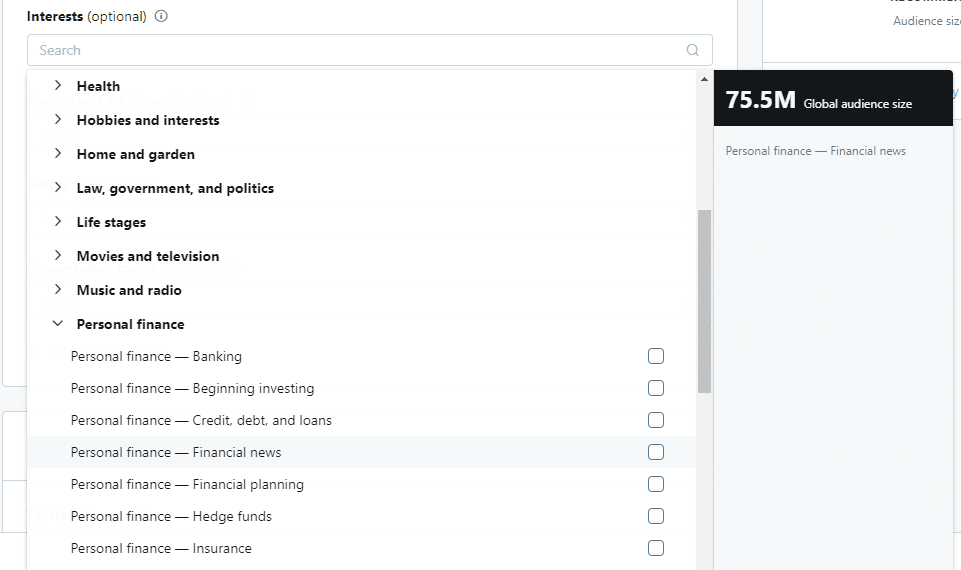
Pro Tip: Create different ad sets for these different user personas. You know who you’re after – now go get ‘em!
Handles
Another powerful feature Twitter Ads offers marketers is that unlike other social advertising platforms, you can directly target followers of your competitors. This contrasts to Facebook, for example, that when using its native UI, only allows you to target either followers of your own page, or those that resemble those who do (or who have previously interacted with one of your other assets linked to Facebook). However, with Twitter, you can literally target by any handle that you wish. This affords marketers an amazing opportunity to achieve wide ranging brand awareness with their mobile app install campaigns, especially for those without a large Twitter following. Whether it’s a direct competitor of yours or an account whose followers would be likely users of your app, simply put, followers of these handles are low hanging fruit that is ripe for the taking.
Important to Remember: Make sure any handle you’re targeting is one with a legitimate following, otherwise you may blow through your budget marketing to bots!
Real Time Events & Conversations
Because Twitter is different from other social platforms in the way its users engage with it, it also presents another unique opportunity when it comes to targeting your audience. This is because with its fast-paced back-and-forth sharing of thoughts and ideas Twitter is truly a hotbed of discussion. Consequently, this presents an excellent opportunity to reach people based on things happening in real-time and take advantage of the buzz. This is especially true for example with political and sporting events where user participation in the discourse is active. As a result, Twitter is constantly updating, identifying those of its users who are talking about these hot items, and thus providing marketers with the chance to compose special lists to reach out to in real-time if the event gets big enough on Twitter.
This differs from a platform like Facebook where you may be trying to reach someone with your ad who chimed in on the Super Bowl this year, but instead it finds its way to someone who did so in last year’s big game. Additionally, Twitter also provides marketers with a means for getting in front of users whose interest in a topic is based on recency. By leveraging its lookback feature, marketers can single out users who have actively sought out the topic of conversation within the past 28 days. This can be another fantastic way to take advantage of opportunities such as in the weeks leading up to holidays while they are fresh on users’ minds.
Pro Tip: While Twitter can pretty much do anything every other social platform can offer and more when it comes to targeting, limit each campaign to only one targeting option in order to avoid creating an overlap.
A Creative Way to Remarket
The internet is filled with articles providing pretty much the same exact message when it comes to your Twitter Ads’ creative. These typically offer the familiar guidance to make sure your campaigns are engaging, to use high-quality visuals with contrasting colors, and if possible to make your ads fun. For that reason, we will not discuss that here. Plus Twitter makes it easy to size them correctly with its Twitter card library.
However, something that is worth taking a deeper look into is how Twitter’s unique user behavior presents some interesting ways in which to structure your creatives. On platforms like Facebook, for example, posts that get engagement almost always must include some sort of media such as an image, GIF, video, or even a combination of them all in the form of a carousel. Text with no accompanying visual very seldom has any chance of garnering significant engagement or going viral. However, because Twitter is engaged with as a news service, as much as (if not more than) a social network, users are very likely to pay attention to content that does not include media.
This creates an interesting use case for marketers to leverage Twitter to develop an effective funnel for their audience simply by taking a less-is-more approach. So what does that look like? The answer, a tweet with no media and just text. As we just mentioned, Twitter is unique from other social platforms when it comes to the type of experience users expect to get from it, which includes tweets with no visuals. A promoted tweet of this style has the potential to be perceived more as organic content rather than an advertisement, and thus draw engagement. Plus, thanks to the retweet button, content on Twitter is incredibly easy to share and thus increases your brand awareness.
Combining those two factors creates an amazing beginning to your marketing funnel. First, you achieve brand awareness with easily engageable and shareable content that most importantly does not look like an ad. Then later you can go back and remarket to that audience who interacted with the tweet using a traditional creative featuring a visual asset that can be easily constructed from one of Twitter’s app install ad cards.
Think Outside the Box: Use emojis, ASCII-art, cool fonts, or even upside-down text to give your promoted tweet-with-no-media some personality and help it stand out from the crowd.
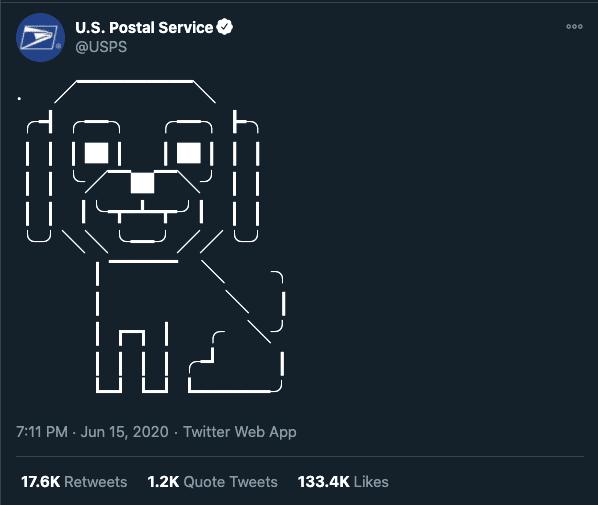
Key Takeaways
Clearly, Twitter is an underappreciated avenue for acquiring mobile users that can be a great source of wins for marketers. It not only provides excellent opportunities to reach new users but when leveraged correctly, one with seemingly less competition than the others.
- Unlike other social platforms, Twitter allows advertisers to set up their app install campaigns to be charged only when their ad results in an install at a specified price, thus allowing you to conduct your learning phase without cost.
- Take advantage of this “free look” to experiment and determine your ideal cost-per-install.
- If you find you’re not able to locate that “sweet spot” and are just wasting your time, simply switch over to the OAB method, pay to allow the algorithm to do its learning, and then switch back to the payment method and leverage your new-found data.
- When it comes to targeting Twitter really is the best of all worlds, offering the same features as the other platforms, as well as its own unique ones including keyword, handles, interests, and time-sensitive events.
- Not only does Twitter allow you to target by keyword, but its algorithm will even interpret user search intent for you.
- Build specific “user personas” for your audiences by choosing interest categories and then drilling down into them to select even more.
- Treat them as attributes that combine to define your ideal users, rather than just listing off what their potential interests are.
- Because Twitter gives you so many topics to work with, it really is a playground for growth hackers when it comes to experimenting, learning more about your ideal users, tweaking, and scaling.
- Targeting by handles is a great way to build a lookalike audience without having a core audience to base it off. However, just make sure you’re targeting accounts with actual people following them and not bots.
- Make the trend your friend, by leveraging the option of targeting those engaging in hot topics of conversation on Twitter both in real-time, or who have expressed an interest in them over the past 28 days.
- Take the long view when it comes to creatives on Twitter. Start by using tweets with no media to spark engagement with your brand, then go back and retarget those users later for the actual app install.
Many marketers fall guilty of bailing on their Twitter Ads campaigns too soon due to not seeing the desired results fast enough. So be patient, be diligent, keep our best practices in mind, and you’ll be reaping the benefits of adding Twitter Ads to your mobile marketing strategy no time.





